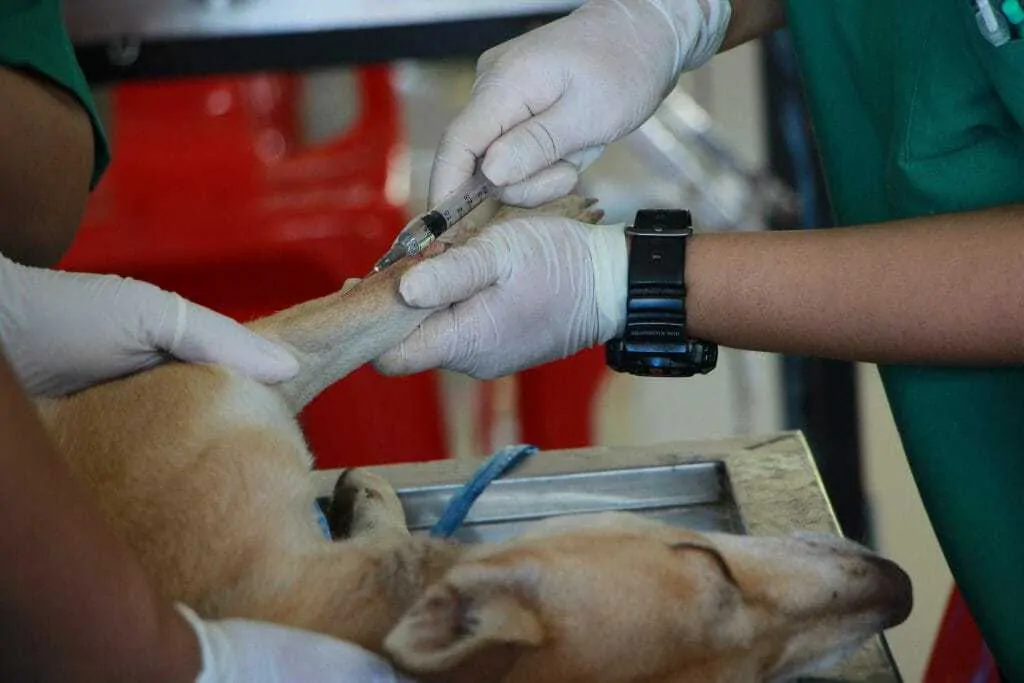Although most pet owners couldn’t put a price on their beloved dog, it’s important to face the fact that owning a dog is expensive – often more expensive than we expect.
Routine vet costs alone will easily cost you hundreds of dollars per year. When you consider the fact that most pet owners will experience at least one $2,000 vet emergency during their pet’s lifetime, you can see how important it is to plan ahead for how you will handle these expenses.
The last thing you want to be worrying about if your dog is injured or sick is how you’re going to afford the care that they desperately need right away. As a Financial Planner I encourage my dog-parent clients to have a dedicated Pet Emergency Fund to ensure that they’ll never have to worry about money during a crisis. But what if you don’t have an emergency fund yet?
Money is the last thing you want to worry about when your dog is sick.
Pet insurance is becoming an increasingly popular way to plan for emergency vet bills. Almost unheard of just a few years ago, pet insurance is now a $1 billion per year industry, and experts expect it to double to $2 billion per year by 2022.
While pet insurance can seem like an easy and affordable way to cover emergency expenses, you may be skeptical about the terms of these plans, wary of the costs, and unsure whether pet insurance is really worth it.
Read on to learn more about what pet insurance is, whether you need it, and how to prepare yourself for a pet emergency. Whether or not pet insurance is for you, planning ahead will give you the peace of mind to focus on what really matters in a crisis – the health and happiness of your dog.
Contents
The True Cost of Vet Emergencies
It’s highly likely that you’ll face an emergency vet bill at some point in your dog’s life.
As a dog owner you will likely experience at least one $2,000+ emergency vet bill. This is on top of the hundreds you will spend on annual preventative care. And these are just the averages – major surgeries and long-term illnesses can cost much more!
Common medical issues like hip dysplasia and diabetes can cost $7,000-$10,000 for surgeries and long-term medications. Emergency surgery for a broken leg or an ingested forgein object can cost $3,000-$4,000. A simple fever can cost up to $9,000 between hospitalization and medication!
On top of the financial costs, the emotional costs can be just as heavy. The last thing you want to worry about when your pet is sick or injured is whether or not you can afford their care. Even if you can afford the bills or can access credit in a pinch, the unexpected expense could set you back financially.
Sadly, every year 3-4 million adoptable pets are euthanized because their owners couldn’t afford the care they needed. Even “economic euthanasia” comes at a cost – it can cost upwards of $250 to put down a dog.
Pet Insurance Basics
In 1982, when Lassie was the first American dog to be covered by pet insurance, there was only one dog and cat insurance company in America. Today, there are more than 80 different companies offering endless pet insurance products that cover everything from cats and dogs to hamsters, rabbits and even exotic pets.
Pet insurance is already a billion dollar industry, and experts expect it to grow to $2 billion by 2022 at a rate of almost 15% per year. And yet less than 1% of North American pet dogs and cats are covered by pet insurance. Consumer awareness is growing, making pet insurance more popular and more affordable – and more complicated.
Like any insurance product, there are endless varieties of plans, companies and features. It can seem overwhelming, but it’s important to understand the basic structure of pet insurance plans and the options available before your make a decision.
Plan Types & Features
Pet Insurance comes in many varieties, covering everything from injuries to routine care.
Types of Plans
There are countless different types of plans for you to choose from, but they generally fall into two categories:
- Accident-Only: These are the most basic types of pet insurance plans, and they are intended to cover injuries caused by an accident – for example, if your dog is hit by a car or breaks her leg. These plans don’t cover illnesses or chronic conditions.
- Comprehensive: Comprehensive plans come in many varieties, and can be endlessly customized. They generally cover both accidental injury and illnesses and chronic conditions, like cancer or arthritis.
Comprehensive plans are the most popular by far – more than 80% of all plans sold in the US are comprehensive plans. Policy Genius has a great chart that compares accident-only and comprehensive plans.
Wellness Coverage is the latest trend in pet insurance – in recent years many companies have started to offer plans and add-ons that cover the costs of routine care, such as vaccines and flea and tick medications.
Terms & Conditions
It pays to know the terms of your plan to avoid surprises at claim time.
Pet insurance plans, like all insurance plans, can have a wide range of confusing terms and conditions. It’s important that you understand the terms of your plan so that there will be no surprises when it comes time to make a claim.
This is especially important because the majority of pet insurance plans are reimbursement plans. This means that you still need to come up with the money to pay your vet bills in advance, and then submit your claim to the insurance company for reimbursement.
If they decline your claim you are still responsible for the vet bills; this is particularly troubling if you borrowed the money to pay your vet bills, and were relying on the insurance payout to repay the loan.
Pet insurance may be a way to make sure you can always afford the care your dog needs.
It’s also important to understand how the reimbursement amount for your plan is calculated. Some plans calculate your reimbursement as a flat percentage of your costs after your deductible. Other plans use the “usual and customary costs” for your area to determine the payout amount, regardless of how much you actually paid.
Plans typically have an annual cap to the amount of claims they will pay out per pet. Some providers let you choose the amount of your maximum (for example, $5,000, $10,000 or $15,000), but more coverage comes at a cost – the higher the maximum annual cap is, the higher your premiums will be.
You’ll also have different choices for your deductible and premiums. Typically, the lower your deductible (the amount you have to pay out of pocket), the higher your premiums.
Providers typically offer both annual and monthly payment plans, and they sometimes even offer discounted rates when you pay the full year’s premium in advance.
How Much Does Pet Insurance Cost?
There are endless ways to customize your pet insurance – and a huge range of costs.
The premiums you will pay for pet insurance will depend on a number of factors, including the breed, age and health of your dog, and the type of plan you choose:
- Breed: Depending on your dog’s breed, you may pay a premium for coverage. This is because certain breeds are more prone to certain health conditions. German shepherds and other large breeds are prone to joint problems like hip dysplasia and arthritis. Hounds and bulldogs can be plagued by eye and ear problems due to their floppy skin. Expect to pay more for coverage for pure-breeds, or face exclusions for certain breed-specific conditions.
- Age: The older your dog is, the higher your premiums are likely to be. Older dogs are more likely to experience health issues, and more likely to have already had some past health problems. Expect to pay more for older dogs or have exclusions for existing health issues.
- Health: If your dog has any pre-existing health issues, you will likely pay extra for insurance coverage. You could also face exclusions for certain illnesses or treatments.
- Plan Type: The more comprehensive your coverage and the more features you choose, the more you will pay. An Accident, Illness and Wellness plan with a flat percentage payout and a low deductible will cost more than a high-deductible, Accident-Only plan for the same dog.
The average cost of pet insurance for a dog is $45 per month, but it can vary widely from dog to dog. Plans can be as low as $10 per month and has high as $100 per month or more. It’s important to understand the terms of your plan, and shop around for the best coverage and rate.
Is Pet Insurance Worth It?
Planning ahead for emergencies gives you peace of mind.
Americans spend more than $70 billion per year on their pets, and almost a quarter of that spending is on vet bills. The financial and emotional costs of a vet emergency can be staggering, so planning ahead is essential.
A Pet Emergency Fund is the best way to ensure you’ll always be able to cover any unexpected vet bills, but pet insurance might also have a place in your pet’s life.
Here are some ways you might consider making pet insurance a part of your financial plan:
-
- As back-up coverage while building your Pet Emergency Fund: Pet insurance can be a great way to protect yourself and your dog in the short term while you work on building up your Pet Emergency Fund. Having coverage in place can help ensure that your savings plans aren’t sidelined by an emergency, and you can always cancel the plan once you have reached your savings goal.
- As a compliment to your Pet Emergency Fund: Although it’s reassuring to know you have a few thousand dollars set aside for a vet emergency, it doesn’t make sense to tie up large amounts of cash for an emergency that may or may not occur. Once you have a good start to your emergency fund to cover minor emergencies, a more basic pet insurance policy can provide an extra layer of protection and peace of mind in case of a major catastrophe.
- As an alternative to a Pet Emergency Fund: If you are financially secure but prefer not to have too much cash laying around, pet insurance could be an alternative to a cash emergency fund. Even if that math works out to show you breaking even or even paying a little more for the coverage, the convenience of a fixed regular payment over finding lump sums in emergencies may be worth the extra cost, as long as you can easily afford the premium payments.
How to Choose Pet Insurance
Planning ahead for emergencies means you can focus on what matters – your dog’s health and happiness.
If you have decided that pet insurance is for you, here are some ways to make sure you’re choosing the right insurance for you and your dog:
Know what you want: Before you start looking for policies, be clear on why you want the coverage.
- Is it temporary or permanent? Will it act as your main long-term emergency plan, or will you cancel it once you’ve built up your savings?
- Are you looking for coverage for all types of illnesses and injuries, or just basic accident-only coverage?
- Do you want your insurance to cover the bulk of your costs, or will you have your own savings to contribute?
Know your options: Once you know what type of coverage you want, you’ll have many decisions to make that can influence your overall cost and coverage:
- How high of a deductible are you willing to pay? The less you have the pay out of pocket, the higher your premiums will be.
- What percentage of expenses do you want covered after the deductible? A higher reimbursement rate means higher premiums.
- What will your annual coverage maximum be? The higher the maximum, the more you’ll pay in annual premiums.
- Be realistic about the amount of coverage you need – there’s no reason to buy more insurance than you need.
Read the fine print: Be sure you completely understand the terms of your contract before you commit:
- What illnesses, injuries and treatments are covered? Are there any exclusions based on pre-existing conditions or your dog’s breed? Be sure to be honest on your application to avoid problems at claim time.
- Do you have the choice of vets, or do you need to work with certain approved providers?
- How is the amount of your reimbursement calculated? Is it a flat percentage, or based on “usual and customary” rates? How are those “usual and customary” rates determined?
- Also be sure to review the basic contract terms – how long it’s in effect, how and why the contract may be terminated, if there are any cancellation fees, and when and how the provider can change premiums, fees and terms.
Ask questions: Don’t just rely on what you’ve read online – with pet insurance becoming increasingly popular, you likely know someone who has some experience shopping for pet insurance. Ask friends and family for recommendations, and check with local vets for their preferred companies. It also doesn’t hurt to call the providers you’re considering directly and ask for a discount – like any contract, it often pays to negotiate.
Check your benefits: Pet Insurance is the latest trend in work perks, so you may have access to coverage or discounts through your employer’s benefits plan.
Final Word on Pet Insurance
A healthy dog is a happy dog.
Pet insurance is becoming increasingly popular, and it can be a great way to minimize the emotional and financial impact of an emergency vet bill while you build your Pet Emergency Fund. But it’s important to remember that, like any insurance product, pet insurance is a financial contract, and you should do your research and ensure you understand all the terms, limitations and costs before you commit to a plan.
Knowing that you’ll be able to cover any emergency vet bills will give you peace of mind, and let you focus on what matters – keeping your dog happy and healthy.









